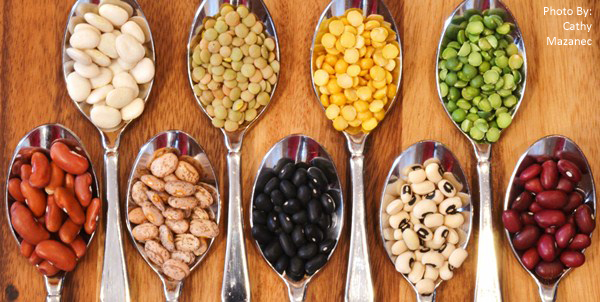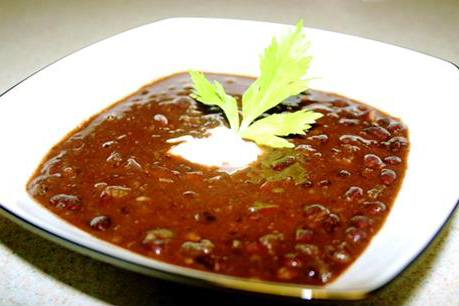Beans aren’t just good for your heart; they’re affordable, convenient, and packed with nutrients that have a wide range of health benefits including lowered LDL cholesterol, blood sugar control, weight management, and more. Beans are an excellent plant-based source of protein and fiber and are rich in minerals such as folic acid, iron, and magnesium.
Did You Know?
- The U.S. is a global leader in bean production, planting 1.5-1.7 million acres of edible dry beans per year. For more information on dried beans, visit the US Dry Bean Council’s website.
- Beans are a good source of the essential amino acid, lysine, which is missing from most grains. Combine whole grains with beans ("rice and beans") to create a complete plant-based protein source.
- You can swap 1 cup of flour for 1 cup of black bean puree in some recipes for a lower calorie alternative with an added boost of fiber and protein! This works best with brownies and cookies. Check out this black bean brownie recipe that will save you over 50 calories and 7 grams of fat per serving!
Ditch the Can!
Ever wonder if it’s really worth the extra time to cook dried beans instead of using canned beans? Let’s do the math!
16 ounce bag of dried black beans
- Cost: $0.89
- Yield (cooked): 6 cups or 12 servings (0.5 cup ea)
- Nutrition Facts per Serving: 70 calories, 0gm fat, 20mg sodium, 23gm carbs, 15gm fiber, 9gm protein
15.25 ounce can of black beans
- Cost: $0.89-$1.45 (average cost= $1.17)
- Yield: 1.5 cups or 3 servings (0.5 cup ea)
- Nutrition Facts per Serving: 110 calories, 1gm fat, 370mg sodium, 19gm carbs, 7gm fiber, 7gm protein
This works out to be $0.07 per serving of cooked dried beans and $0.39 per serving of pre-cooked canned beans. That’s a saving of $0.32 per serving which may not sound like a lot but it adds up quickly! You’re also saving over 350mg of sodium with each serving and you can control the seasonings and ingredients.
Bean Cuisine
Now that we’ve hopefully convinced you to give dry beans a try, you’re probably wondering, "How do I cook dried beans?"
Step 1: Thoroughly rinse and drain dry beans, discarding any damaged beans or foreign particles such as pebbles or rocks.
Step 2: Choose cooking method. To soak or not to soak? For details on different cooking methods and suggested cooking times, click here.
Step 3: Properly store leftover beans. Cooked beans can be safely stored in the refrigerator for up to 5 days in a sealed container and in the freezer for up to 3-6 months.
Tip: Cook a large batch of dry beans and store in freezer-safe containers in 1.5 cup portions (equivalent to 1 can of pre-cooked beans). The next time a recipe calls for a can of beans, voila, you have homemade beans ready to go! To defrost, place container in hot water for 5 minutes, let thaw overnight in refrigerator, or add into recipe still frozen.
Slow Cooker Black Bean Soup
Recipe Adapted from Babble: The Family Kitchen
Makes 8 Servings
Ingredients
1 Tbsp extra virgin olive oil
1 large onion, chopped
4 celery stalks, chopped (include leaves for added flavor)
1 red bell pepper, chopped
1 green bell pepper, chopped
4 garlic cloves, minced
1 Tbsp cumin
1 Tbsp chili powder (could use chipotle en adobo instead to add a smoky taste)
16 oz package (or 2 cups) dried black beans
7 cups low sodium chicken or vegetable broth
Juice of 1 lime
Coarse sea salt, to taste
Optional Toppings: plain Greek yogurt, sour cream, lime wedges, fresh chopped bell peppers
Directions
- Heat olive oil in large skillet over medium-high heat. Add onions, celery and pepper and sauté until soft and turning translucent. Add garlic, cumin, and chili powder and cook for another minute. Transfer mixture to 6-quart slow cooker and add beans and broth.
- Cover and cook on low for 8-10 hours.
- Add salt, to taste, and fresh lime juice and stir well.
- Using a handheld immersion blender, puree slightly until desired consistency is reached. Ideally, the soup should be half smooth, half chunky. If you don’t have an immersion blender, scoop out about half of the soup and transfer to a blender; puree until smooth.
- Top with desired toppings, and serve hot.



2 Comments
Pingback: 5 Powerful Foods For Your Heart - SAS Life
Pingback: Is Butter Back? - SAS Life